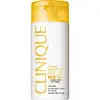What's inside
What's inside
 Key Ingredients
Key Ingredients

 Benefits
Benefits

 Concerns
Concerns

 Ingredients Side-by-side
Ingredients Side-by-side

Water
Skin ConditioningOctocrylene
UV AbsorberEthylhexyl Salicylate
UV AbsorberPropanediol
SolventButyl Methoxydibenzoylmethane
UV AbsorberPolymethyl Methacrylate
Dimethicone
EmollientPhenylbenzimidazole Sulfonic Acid
UV AbsorberPolysilicone-15
UV FilterPropylene Glycol Dicaprylate/Dicaprate
EmollientTromethamine
BufferingBis-Ethylhexyloxyphenol Methoxyphenyl Triazine
Skin ConditioningSilica
AbrasiveDimethicone/Vinyl Dimethicone Crosspolymer
Skin Conditioning1,2-Hexanediol
Skin ConditioningPolysorbate 60
EmulsifyingPEG-10 Dimethicone
Skin ConditioningSodium Hyaluronate
HumectantTocopheryl Acetate
AntioxidantXanthan Gum
EmulsifyingCaprylyl Glycol
EmollientParfum
MaskingDisodium EDTA
PEG-8
HumectantTocopherol
AntioxidantTropolone
Skin ConditioningAscorbyl Palmitate
AntioxidantAscorbic Acid
AntioxidantCitric Acid
BufferingWater, Octocrylene, Ethylhexyl Salicylate, Propanediol, Butyl Methoxydibenzoylmethane, Polymethyl Methacrylate, Dimethicone, Phenylbenzimidazole Sulfonic Acid, Polysilicone-15, Propylene Glycol Dicaprylate/Dicaprate, Tromethamine, Bis-Ethylhexyloxyphenol Methoxyphenyl Triazine, Silica, Dimethicone/Vinyl Dimethicone Crosspolymer, 1,2-Hexanediol, Polysorbate 60, PEG-10 Dimethicone, Sodium Hyaluronate, Tocopheryl Acetate, Xanthan Gum, Caprylyl Glycol, Parfum, Disodium EDTA, PEG-8, Tocopherol, Tropolone, Ascorbyl Palmitate, Ascorbic Acid, Citric Acid
Titanium Dioxide 3.2%
Cosmetic ColorantZinc Oxide 2%
Cosmetic ColorantWater
Skin ConditioningDimethicone
EmollientCaprylyl Methicone
Skin ConditioningButyloctyl Salicylate
Skin ConditioningIsononyl Isononanoate
EmollientNeopentyl Glycol Diheptanoate
EmollientDimethicone/PEG-10/15 Crosspolymer
Butylene Glycol
HumectantDiethylhexyl Succinate
EmollientDipentaerythrityl Tri-Polyhydroxystearate
EmollientC12-15 Alkyl Benzoate
AntimicrobialLauryl PEG-9 Polydimethylsiloxyethyl Dimethicone
Skin ConditioningTrimethylsiloxysilicate
EmollientHydroxyapatite
AbrasiveCetyl PEG/PPG-10/1 Dimethicone
EmulsifyingMethyl Trimethicone
Skin ConditioningHydrolyzed Wheat Protein/Pvp Crosspolymer
Caprylyl Glycol
EmollientDimethicone Silylate
Quaternium-90 Bentonite
Sodium Chloride
MaskingTriethoxycaprylylsilane
Dimethicone Crosspolymer-3
Skin ConditioningIsostearic Acid
CleansingSilica
AbrasivePolyhydroxystearic Acid
EmulsifyingPropylene Carbonate
SolventSodium Citrate
BufferingDisodium EDTA
Phenoxyethanol
PreservativeCI 77492
Cosmetic ColorantCI 77491
Cosmetic ColorantTitanium Dioxide 3.2%, Zinc Oxide 2%, Water, Dimethicone, Caprylyl Methicone, Butyloctyl Salicylate, Isononyl Isononanoate, Neopentyl Glycol Diheptanoate, Dimethicone/PEG-10/15 Crosspolymer, Butylene Glycol, Diethylhexyl Succinate, Dipentaerythrityl Tri-Polyhydroxystearate, C12-15 Alkyl Benzoate, Lauryl PEG-9 Polydimethylsiloxyethyl Dimethicone, Trimethylsiloxysilicate, Hydroxyapatite, Cetyl PEG/PPG-10/1 Dimethicone, Methyl Trimethicone, Hydrolyzed Wheat Protein/Pvp Crosspolymer, Caprylyl Glycol, Dimethicone Silylate, Quaternium-90 Bentonite, Sodium Chloride, Triethoxycaprylylsilane, Dimethicone Crosspolymer-3, Isostearic Acid, Silica, Polyhydroxystearic Acid, Propylene Carbonate, Sodium Citrate, Disodium EDTA, Phenoxyethanol, CI 77492, CI 77491
 Reviews
Reviews

Ingredients Explained
These ingredients are found in both products.
Ingredients higher up in an ingredient list are typically present in a larger amount.
Caprylyl Glycol is a humectant and emollient, meaning it attracts and preserves moisture.
It is a common ingredient in many products, especially those designed to hydrate skin. The primary benefits are retaining moisture, skin softening, and promoting a healthy skin barrier.
Though Caprylyl Glycol is an alcohol derived from fatty acids, it is not the kind that can dry out skin.
This ingredient is also used as a preservative to extend the life of products. It has slight antimicrobial properties.
Learn more about Caprylyl GlycolDimethicone is a type of synthetic silicone created from natural materials such as quartz.
What it does:
Dimethicone comes in different viscosities:
Depending on the viscosity, dimethicone has different properties.
Ingredients lists don't always show which type is used, so we recommend reaching out to the brand if you have questions about the viscosity.
This ingredient is unlikely to cause irritation because it does not get absorbed into skin. However, people with silicone allergies should be careful about using this ingredient.
Note: Dimethicone may contribute to pilling. This is because it is not oil or water soluble, so pilling may occur when layered with products. When mixed with heavy oils in a formula, the outcome is also quite greasy.
Learn more about DimethiconeDisodium EDTA plays a role in making products more stable by aiding other preservatives.
It is a chelating agent, meaning it neutralizes metal ions that may be found in a product.
Disodium EDTA is a salt of edetic acid and is found to be safe in cosmetic ingredients.
Learn more about Disodium EDTASilica, also known as silicon dioxide, is a naturally occurring mineral. It is used as a fine, spherical, and porous powder in cosmetics.
Though it has exfoliant properties, the function of silica varies depending on the product.
The unique structure of silica enhances the spreadability and adds smoothness, making it a great texture enhancer.
It is also used as an active carrier, emulsifier, and mattifier due to its ability to absorb excess oil.
In some products, tiny microneedles called spicules are made from silica or hydrolyzed sponge. When you rub them in, they lightly polish away dead skin layers and enhance the penetration of active ingredients.
Learn more about SilicaWater. It's the most common cosmetic ingredient of all. You'll usually see it at the top of ingredient lists, meaning that it makes up the largest part of the product.
So why is it so popular? Water most often acts as a solvent - this means that it helps dissolve other ingredients into the formulation.
You'll also recognize water as that liquid we all need to stay alive. If you see this, drink a glass of water. Stay hydrated!
Learn more about Water